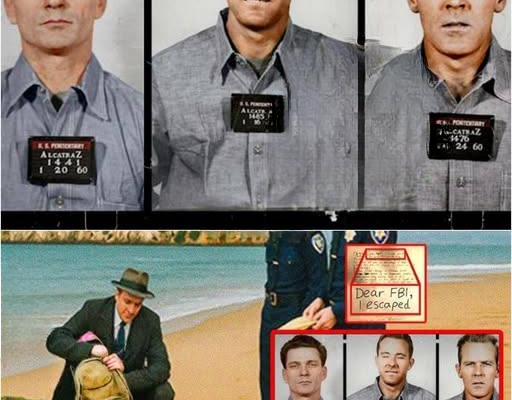
A Night That Changed History
On a cold, moonless evening in June 1962, the notorious prison island of Alcatraz was about to witness one of the boldest acts of defiance in modern history. Three men—Frank Morris and brothers John and Clarence Anglin—moved quietly through the steel-and-concrete corridors of America’s most “escape-proof” penitentiary. Hours later, they would vanish into the frigid waters of San Francisco Bay, leaving behind only scattered clues, a baffled prison staff, and a mystery that has captivated the world for more than half a century.
For decades, the fate of these men remained uncertain. Did they perish in the unforgiving waters, or did they succeed in pulling off the impossible—escaping the Rock and building new lives in secret? Thanks to new research and advanced technology, fresh insights have brought us closer than ever to unraveling this mystery.
Alcatraz: America’s Fortress in the Bay
Why Alcatraz Was Considered Escape-Proof
Alcatraz Federal Penitentiary was more than a prison—it was a symbol of ultimate security. Located on a rocky island in the middle of San Francisco Bay, the facility was deliberately chosen for its natural defenses. Freezing waters, swirling currents, frequent fog, and jagged rocks formed a deadly moat that made escape seem impossible.
Opened in 1934, Alcatraz housed some of the most notorious criminals of the 20th century. Among its inmates were mobster Al Capone, George “Machine Gun” Kelly, and other figures who had previously managed to outwit lesser institutions. The prison’s mission was simple: keep the “worst of the worst” under lock and key, far from society, in a place where the odds of escape were virtually zero.
The Escape Record Before 1962
Over its 29 years as a federal prison, Alcatraz saw 36 men attempt 14 separate escape plans. The results were grim: six were shot, two drowned, and the rest were recaptured. Until Morris and the Anglin brothers, no one had ever managed to truly disappear. The government proudly touted Alcatraz as inescapable. Yet, in June 1962, that perception would change forever.
The Men Behind the Plan
Frank Morris: The Mastermind
Frank Morris was known for his intelligence and resourcefulness. Having endured a difficult childhood and a series of petty crimes, he developed a reputation as a highly skilled escape artist. His IQ reportedly ranked in the top 2% of the population, making him exceptionally capable of devising complex plans.
The Anglin Brothers: Loyal and Determined
John and Clarence Anglin, originally from Georgia, came from a large family of farmers. They had been involved in a series of robberies before landing in Alcatraz. Known for their quiet loyalty to each other, the brothers had strong swimming skills—an asset that would prove critical in their escape attempt.
Allen West: The Fourth Conspirator
Allen West, another inmate, was part of the planning but failed to make it out on the final night. His role in the conspiracy later provided investigators with key details about the preparation and execution of the escape.
Crafting the Escape: Ingenuity Behind Bars
Tools of Desperation
Months of careful planning went into the operation. Using stolen spoons, a drill improvised from a vacuum cleaner motor, and simple persistence, the men widened ventilation shafts in their cells. To cover up the damage, they created fake grates that blended with the wall.
Fooling the Guards
Perhaps the most ingenious part of the plan was the creation of life-like dummy heads. Constructed from soap, toilet paper, and hair taken from the prison barber shop, these decoys were placed in their beds at night. Guards making their rounds saw only what looked like peacefully sleeping inmates.
The Escape Vessel
The men stitched together over 50 stolen raincoats to form both life vests and a makeshift raft. This DIY craft, inflated with a concertina, represented their one chance of survival across the icy bay.
The Night of June 11, 1962
As darkness fell, Morris and the Anglin brothers put their plan into motion. They crawled through their cell walls, climbed into an unused service corridor, and navigated their way to the roof. From there, they slid down pipes, crossed a fenced prison yard, and carried their homemade raft to the shoreline.
By morning, the guards discovered the ruse. The dummy heads fooled them until it was too late. Panic spread as officials realized three men had vanished from the Rock. The only trace found later was a deflated raft and some personal items on nearby Angel Island. No bodies were ever recovered.
The Official Verdict: Presumed Dead
The FBI launched an enormous manhunt, deploying helicopters, boats, and ground teams to scour the bay and coastline. Posters went up nationwide, families were watched, and tips were investigated. Yet no conclusive evidence emerged. By 1979, the FBI declared the men likely drowned in the attempt, closing its investigation.
But not everyone was convinced. Many questioned whether men so resourceful could have come this far only to perish at the final hurdle. This doubt fueled endless speculation, keeping the mystery alive.
A Mystery That Refused to Die
Rumors and Theories
Over the decades, theories emerged. Some believed the escapees were aided by outside accomplices or criminal networks. Others suspected corrupt guards turned a blind eye. A popular belief was that the men successfully crossed the bay and fled to South America, where they started new lives under assumed identities.
The 2013 Letter
In 2013, the San Francisco Police Department received a letter claiming to be from John Anglin. The writer insisted that he, his brother Clarence, and Frank Morris had survived the escape. The letter mentioned personal details that suggested authenticity. However, handwriting analysis was inconclusive, and authorities never confirmed its legitimacy. Still, the letter reignited public interest in the case.
MythBusters and Feasibility
Television programs such as MythBusters tested whether such an escape was possible. By reconstructing the raft and navigating the bay under similar conditions, they demonstrated survival was indeed feasible. While this didn’t prove the escapees’ fate, it reinforced the possibility that they succeeded.
Technology Joins the Investigation
In 2018, a grainy 1975 photograph from Brazil surfaced, showing two men thought to resemble the Anglin brothers. Though unclear, it attracted significant attention. This time, experts turned to artificial intelligence.
An Irish creative agency, Rothco, partnered with U.S.-based Ident TV, a company specializing in AI facial recognition. Using advanced algorithms, they analyzed facial structures, posture, and features—accounting for aging and image quality. Their findings strongly suggested the men in the photo could indeed be John and Clarence Anglin.
Implications of the AI Findings
The AI analysis did more than revive interest in an old case—it challenged the assumption that the men had drowned. If true, it meant that three determined inmates had successfully beaten the most secure prison of its time, disappearing into history and outsmarting one of the strongest law enforcement agencies in the world.
The Cultural Legacy of the Alcatraz Escape
In Popular Culture
The escape has inspired countless books, documentaries, and films, most notably Escape from Alcatraz starring Clint Eastwood. These portrayals have immortalized the story, blending fact and myth into a narrative that continues to captivate global audiences.
Symbol of Human Determination
Beyond entertainment, the story has become a metaphor for resilience, creativity, and the pursuit of freedom. It illustrates how, even in the most restrictive environments, the human spirit finds ways to resist and endure.
Lessons from the Rock
- Ingenuity in Adversity – The escapees turned limited resources into a viable plan, proving the power of resourcefulness.
- Persistence of Mystery – Even officially “closed” cases may hold secrets that resurface decades later.
- The Role of Technology – Modern tools like AI and forensic science can provide new insights into old mysteries.
- Cultural Resonance – Stories of daring escapes remind us of the universal human drive toward freedom.
Conclusion: A Mystery Half-Solved
More than 60 years later, the Alcatraz escape remains one of the greatest unsolved mysteries in American history. Whether Morris and the Anglin brothers drowned in the bay or lived quietly in exile, their story continues to inspire debate and fascination.
What is certain is that their daring plan forever changed how the world viewed Alcatraz. Once deemed inescapable, the Rock became the stage for a story of courage, cleverness, and audacity that refuses to fade with time. Modern technology may yet provide the final chapter, but until then, the Alcatraz escape stands as a powerful reminder of human ingenuity—and the enduring allure of the unknown.



